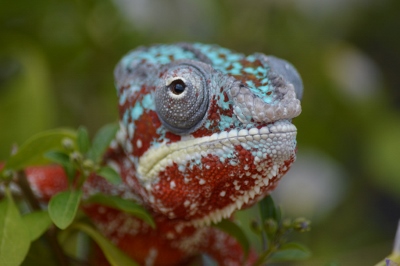
The colourful panther chameleon is bidding us adieu as our Animal of the Month and is heading off to somewhere warm (perhaps to Madagascar?) now that chilly February is almost over. We hope you were following us on Twitter @ExoticPetVets and enjoying our tweets on these unique reptiles. If not, here is a summary of the tweets you missed. Did you know?:
- Chameleons make up the family Chamaeleonidae, which is a very distinct group of lizards.
- Chameleons are mostly found on sub-saharan Africa’s mainland and Madagascar.
- Chameleons can also be found in the warm climates of southern Europe and south Asia.
- Chameleons have also been introduced to the American states of Florida, California and Hawaii.
- The panther chameleon (Furcifer pardalis) is one of more than 150 species of chameleon.
- Native to northern and eastern Madagascar, panther chameleons are different colours depending on their originating locale.
- Male panther chameleons typically grow to 17 inches (45 cm) and sport vibrant colours.
- Female panther chameleons are smaller and don’t have colours that are as bright as their males counterparts.
- It’s a myth that chameleons can change colour to match their environment.
- Panther chameleons change colour depending on the ambient temperature and light.
- Panther chameleons also change colour to communicate things like mood, dominance or the acceptance/rejection of a mate.
- Panther chameleons don’t move quickly – they let their extremely long tongues catch their meals for them.
- Panther chameleons are able to extend their tongues to catch prey in a fraction of a second.
- The chameleon’s tongue has a muscle on the end of it which forms a kind of sticky suction cup which traps the prey.
- After the prey is trapped at the end of the tongue, the chameleon retracts the tongue quickly back into the mouth.
- In the wild, panther chameleons will eat a variety of insects.
- In captivity panther chameleons eat mostly crickets, but should be given variety like hornworms, waxworms and roaches.
- Like all chameleons, panther chameleons have very unique eyes that can move independently of each other.
- Each of the panther chameleon’s eyes has a small eyelid opening on a large bulbous eye ball.
- The iris and pupil are visible through the opening in the middle of the panther chameleon’s eyelid.
- Panther chameleons can rotate each eye independently and focus on two different things at the same time.
- Panther chameleons have five toes on each foot fused together in one group of two and a second group of three.
- Panther chameleons’ unique feet allow them to grasp and move well among tree branches.
- Foot shape is part of the panther chameleon’s scientific name “Furcifer,” which comes from furci – Latin meaning forked.
- Of the common chameleons kept as pets, panther chameleons are generally one of the most docile.
- Like all chameleons, panther chameleons like to be left alone and shouldn’t be handled too much.
- Chameleons are among the most difficult reptiles to keep as a pet and are not for the novice or first-time reptile owner.

